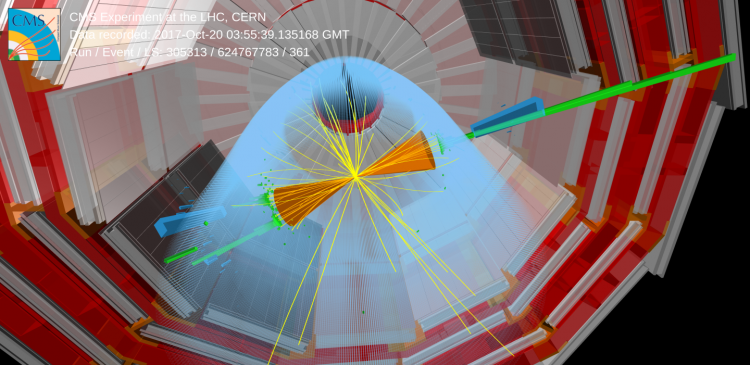
In Frozen, Anna and Elsa discover magical powers that open up a whole new world of possibilities. In Frozen 2, they go far Into the Unknown to understand the source of the magic that binds them all together. The CMS experiment is doing the same with the Higgs boson by exploring it at the highest energies possible.
A new result from the CMS experiment at the CERN Large Hadron Collider (LHC) examines the production of very energetic Higgs bosons to test the Standard Model and look for clues from new physics.
The observation of the Higgs boson in 2012 opened an exciting means to search for hints of new physics beyond the Standard Model that might help illuminate mysteries such as the nature of dark matter and the matter-antimatter asymmetry. One approach is to directly look for new particles that talk to the Higgs boson or to look for its cousins while another relies on measuring its properties and looking for deviations from its expected properties in the Standard Model, our current best picture of particle physics. In this recent result by CMS, physicists explored Higgs bosons that were produced with high transverse momenta, or a lot of Lorentz boost, as a way of prodding the Standard Model to give us a hint of potential new physics.
Searching for an energetic boosted Higgs boson allows physicists to be indirectly sensitive to new physics at mass scales that may be too heavy to be observed directly at the LHC. In quantum field theory, these indirect hints are new particles that are produced virtually, meaning they pop in and out of existence only just momentarily. These virtual new particles can cause large deviations in the number, or rate, of Higgs bosons produced as a function of transverse momentum. For many new physics scenarios, the biggest deviations from the Standard Model are at the highest boost, but producing a Higgs boson with such high energy is very rare.
The CMS experiment searched for highly boosted Higgs bosons that decayed to b quarks. Because the Higgs boson is so energetic, the b quarks are produced very closely together within a single spray of particles called a jet. Jets are copiously produced at the LHC and thus, there are large backgrounds that can mimic the Higgs boson signature. To maximize the sensitivity, deep learning techniques are used to pick out special jets that consist of two overlapping “prongs” of particles and contain two b quarks. The new deep learning classifier is 50% more powerful in picking out Higgs bosons compared to previous methods. The event display below shows a picture of a Higgs boson candidate jet (on the left), which has a two prong structure seen by the green energy deposits in the detector, that is balanced out by another energetic jet.
![]()
Figure 1: Event display showing a Higgs boson jet candidate on the left.
The CMS experiment studied Higgs bosons with transverse momenta up to 1200 GeV, meaning the Higgs bosons travel at 99.5% of the speed of light or more, far beyond where any other analysis has explored. This gives unprecedented sensitivity to new virtual particles that talk to the Higgs boson. The figure below shows the mass distribution of the candidate Higgs boson jets after all analysis selections. The Higgs boson signal is small but visible (in magenta) with a significance of 2.5 standard deviations over the background. We expect, in the Standard Model, to see 0.7 standard deviations. The observed Higgs boson production rate being higher than expected makes the result intriguing, though not statistically significant, and something to follow closely with the new batch of data.
 Figure 2: Mass distribution for Higgs boson candidate jets. The magenta distribution is the Higgs boson signal over the background.
Figure 2: Mass distribution for Higgs boson candidate jets. The magenta distribution is the Higgs boson signal over the background.
Looking forward, CMS will continue to get a clearer picture by studying the high boost region with other Higgs decay final states and with more data coming in Run 3 starting in 2021, and then the high-luminosity LHC era starting in 2027. The story of the boosted Higgs boson has just started -- stay tuned for future results to see how this movie ends!
Read more about these results:
- CMS Physics Analysis Summary "Inclusive search for a highly boosted Higgs boson decaying to a bottom quark-antiquark pair at sqrt(s)=13 TeV with 137 fb-1"
- All CMS physics briefings
- All CMS journal publications
- All CMS preliminary results
- All CMS results
(*) One of the CMS physicists authoring this article must have a 4-year old daughter...
- Log in to post comments

